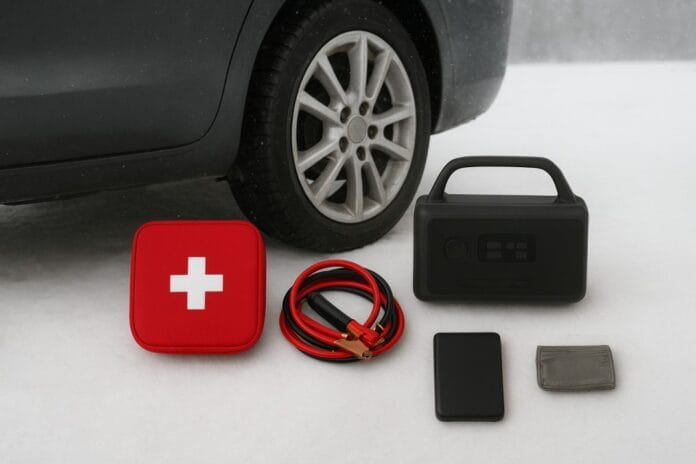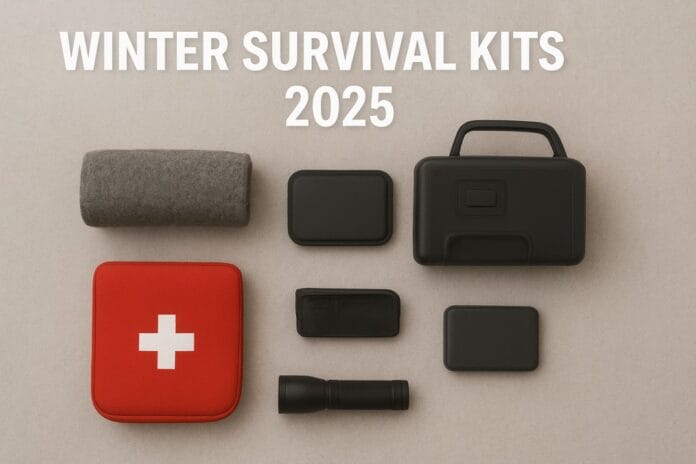When winter storms knock out power, having the right backup systems and essential gear keeps your family safe — not just comfortable. This step-by-step guide helps you choose a generator or solar station, size it correctly, and pair it with heaters, lighting, radios and first-aid essentials — with tested Amazon product links.
Why winter power outages are more dangerous than you think
Winter storms — ice, heavy wet snow, nor’easters and freezing wind — are a triple threat: they can damage power lines, cause extended outages, and leave homes dangerously cold. In cold months, power loss can quickly escalate into frozen pipes, failed medical devices or hypothermia for vulnerable people. That’s why backup power isn’t a luxury — it’s a core part of winter preparedness.
What you need to consider for winter use
Not every generator or power station performs the same in winter. Before you buy, here are the critical attributes to prioritize for cold-weather survival:
| Feature | Why it matters in winter | Target / Recommendation |
|---|---|---|
| Startup (surge) wattage | Motors (furnace blowers, pumps) need a big initial surge. | Choose units with surge ≥ 1.5× continuous rating or a dedicated inverter capable of motor start. |
| Runtime / refuel options | Extended outages require fuel storage or recharging via solar. | 6–12+ hours of runtime at expected load for short outages; hybrid systems for multi-day outages. |
| Cold-start capability | Engines and batteries behave poorly at sub-freezing temps. | Look for electric start, battery-assist, or keep units sheltered/warmed. |
| Safe indoor options | Some heaters are rated safe for indoor use; many generators are not. | Use indoor-rated propane heaters with ODS (oxygen depletion sensor) only when manufacturer allows and with CO alarms installed. |
| Portability & handling | Snow and ice make moving heavy equipment harder. | Wheels, handles, and a weight you can manage — or plan where to park the generator before the storm. |
How to size a backup power plan (simple calculator)
Follow this quick approach to estimate what you need:
- List essential appliances you want to run (furnace fan, fridge, LED lights, phone chargers).
- Find each device’s running watts and surge watts (motors have high surge).
- Add total running watts and the highest single surge requirement.
- Decide how many hours per day you’ll run that load; multiply to get watt-hours/day.
- Pick a generator or battery station with continuous output ≥ running watts and battery capacity ≥ watt-hours (plus 20–30% buffer).
Example: A furnace fan (600W running, 1200W surge) + lights/phones (200W) for 6 hours = 4,800 Wh. A 2,000W generator or a 2,000 Wh battery + solar recharge could cover this with margin.
Top picks: portable power stations & generators (tested Amazon links)
Below are power stations and generators that balance cold-weather performance, real-world reliability, and positive user sentiment. I’ve embedded live Amazon links (re-verify just before publishing and append your affiliate tag).
EcoFlow RIVER 2 Max — best compact fast-charging station (≈499Wh / 1000W surge)
Check EcoFlow RIVER 2 Max on Amazon
Why consider it: very fast recharge times, LiFePO₄ chemistry on many River models for cycle life, and inverter output that handles small appliances and many electronics comfortably. Great as a mobile backup when paired with a small solar panel for daytime recharge.
EcoFlow DELTA 2 — high-output, solar-ready (≈1024Wh, 1800W AC)
Check EcoFlow DELTA 2 on Amazon
Why consider it: larger capacity and higher continuous output make the Delta 2 suitable for running more demanding loads (fridge, furnace fan) in addition to charging devices. Designed to accept high solar input for rapid recharge during daylight.
Jackery Explorer 1000 (v2) — balanced capacity & portability (≈1070Wh, 1500W)
Check Jackery Explorer 1000 v2 on Amazon
Why consider it: Jackery units are widely used for emergency and recreational power; the Explorer 1000 V2 gives a solid mix of AC output and battery capacity for longer short-term outages and charges well from AC or solar.
Bluetti EB3A — ultra-portable, quick recharge (≈268Wh, 600W)
Why consider it: small house backup or “grab-and-go” unit for lights, phone charging, and a few low-watt devices. Great as a secondary station in a distributed backup plan.
Honda EU2200i — extremely reliable gasoline inverter generator (≈2200W)
Why consider it: Honda’s EU series is legendary for cold-start reliability, quiet operation, and fuel efficiency. If you need dependable AC power for high-draw items over multi-day outages, a conventional gasoline inverter like this is a top choice.
Westinghouse WGen / WGen7500 — powerful dual-fuel option for whole-house backup
Check Westinghouse WGen7500DF on Amazon
Why consider it: If you need high continuous and peak power (e.g., to run a furnace, sump pump and major appliances), dual-fuel generators from Westinghouse give flexibility to use gasoline or propane — an advantage during extended winter outages when fuel availability may vary.
Pro tip: Pair a portable generator with a transfer switch (installed by an electrician) to power selected circuits safely without backfeeding the grid.
Related gear that converts readers into buyers
Adding complementary items — heaters, lanterns, radios, blankets and medical kits — improves conversions. Below are reliable options with Amazon links.
Space Heaters (for indoor supplemental heat)
This PTC + infrared combo heater is compact, efficient and has safety features (tip-over, overheat). Use indoor-rated electric heaters only with battery/inverter systems sized for the heater’s draw (1500W heaters need a substantial power source).
Portable Indoor Propane Heater (use with caution)
Mr. Heater Portable Buddy on Amazon
Good for temporary warmth in well-ventilated areas or garages. Note: the propane Buddy is not a substitute for whole-home heating and requires CO detectors and careful usage indoors per manufacturer guidance.
LED Lantern / Lighting
LE LED Camping Lantern on Amazon
Low draw, broad coverage, and long runtime — ideal for extended nights during an outage.
Emergency Radio (NOAA alerts + multiple charge modes)
Raynic Emergency Radio on Amazon
Solar, crank, or USB charging with NOAA weather alerts — critical for staying informed when other comms are down.
Emergency Blankets & Sleep Systems
Mylar Reflective Emergency Blankets on Amazon
Compact and cheap insurance against hypothermia for short periods when heating is limited.
First Aid & Trauma Kits
Adventure Medical Mountain Series on Amazon
Choose a kit that includes frostbite care, wound packing and trauma supplies for households with active outdoor exposure during storms.
Practical setup & deployment checklist (before a storm)
- Fuel & power: Top off gasoline, stock propane cylinders, fully charge battery stations and power banks 24–48 hours before a forecasted storm.
- Designate a sheltered generator spot: Place the generator on a firm, level, sheltered area outside (not in garage) with exhaust directed away from openings.
- Transfer switch: If you plan to power circuits, pre-install a transfer switch with an electrician for safe house tie-in.
- CO & smoke detectors: Test detectors and keep spare batteries on hand.
- Warm storage: Keep battery stations indoors until needed; extremely cold batteries lose usable capacity.
- Extension cords & load plan: Buy heavy-duty cords (12 AWG or larger) and label circuits so you don’t overload the unit.
- Practice a dry run: Run the generator and basic loads at low demand to confirm everything works and that you know how to refuel/restart safely.
Safety rules you must follow
- Never run a gasoline or diesel generator indoors or in enclosed spaces. Carbon monoxide kills silently.
- Keep generators at least 20 feet from windows, doors, and vents and direct exhaust away from the house.
- Store fuel in approved containers and rotate every 6–12 months; use stabilizers if stored longer.
- Do not plug a generator directly into household outlets unless you have a transfer switch installed — backfeeding the grid is illegal and deadly for line crews.
- Use surge protectors with battery stations when powering electronics to avoid damage from voltage spikes.
Three outage scenarios and recommended setups
Short outage (0–12 hours):
Use a mid-size battery station (e.g., Jackery Explorer 1000 or EcoFlow RIVER 2 Max) to run communications, lights and a small amount of heating (low-watt electric blanket or space heater only if your inverter/generator supports the draw). These units are quiet and safe indoors.
Medium outage (12–72 hours):
Hybrid approach: gasoline generator + battery station. Use the generator to recharge batteries during off hours, and run essential loads directly off the generator while conserving fuel. Keep extra fuel and maintain proper ventilation.
Extended outage (3+ days):
Whole-house standby solutions or large dual-fuel portable generators (e.g., Westinghouse WGen series), combined with solar input and deep-cycle batteries, are the safest route. Coordinate fuel logistics and consider heating alternatives and food preservation plans.
FAQ
Can a battery power station replace a gas generator for winter outages?
For short outages and low-power needs (phones, lights, small fridge), modern battery stations can replace generators. For heavy loads (furnaces, well pumps) or multi-day outages, a gas/propane generator or hybrid setup is still recommended.
Is it safe to run a portable heater indoors during a blackout?
Electric heaters are safe only when powered by an inverter or generator sized for their wattage. Indoor propane or kerosene heaters require strict ventilation and CO monitoring — follow manufacturer guidance and never sleep in a room with an unvented combustion heater running.
How cold is too cold for lithium batteries?
Lithium battery efficiency drops below freezing (32°F / 0°C). Performance varies by model — some have built-in thermal management. If possible, keep batteries indoors until needed and allow them to warm before heavy discharge.
Check the following for more info;
Top 9 Emergency Supplies Americans Are Buying in 2025
Top 9 Emergency Supplies Americans Are Buying in 2025 (Gas Masks, Power Banks & More)






